Citroen C3 PICASSO 2013 1.G Owner's Guide
Manufacturer: CITROEN, Model Year: 2013, Model line: C3 PICASSO, Model: Citroen C3 PICASSO 2013 1.GPages: 284, PDF Size: 8.85 MB
Page 21 of 284

.Familiarisation
19
Speed limiter "LIMIT"
Display in the instrument
panel
1.
Limiter mode Selection / Off. 2.Decrease the programmed value.3.Increase the programmed value.4.
Speed limiter On / Off. The cruise control or speed limiter mode
appears in the instrument panel when it isselected. 1
.Cruise control mode Selection / Off.2. Programming a speed / Decrease the
programmed value.3. Programming a speed / Increase the
programmed value.
4. Cruise control Off / Resume.
Cruise control "CRUISE"
In order to be programmed or activated, the
vehicle speed must be higher than 25 mph(40 km/h), with at least fourth gear engaged on
the manual gearbox. The values must be set with the en
gine running. Cruise control
Speed limite
r
Driving safely
136
138
Page 22 of 284
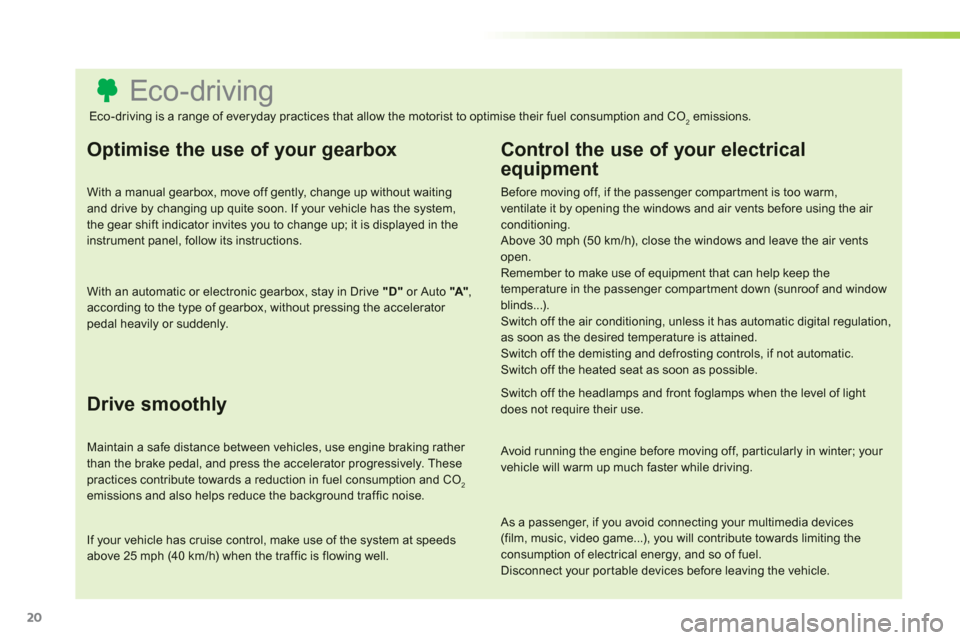
20
Eco-driving
Optimise the use of your gearbox
With a manual gearbox, move off gently, change up without waitingand drive by changing up quite soon. If your vehicle has the system,the gear shift indicator invites you to change up; it is displayed in the instrument panel, follow its instructions.
With an automatic or electronic gearbox, stay in Drive "D"
or Auto "A",according to the type of gearbox, without pressing the accelerator pedal heavily or suddenly.
Drive smoothly
Maintain a safe distance between vehicles, use engine braking rather than the brake pedal, and press the accelerator progressively. Thesepractices contribute towards a reduction in fuel consumption and CO2emissions and also helps reduce the background traffic noise.
If your vehicle has cruise control, make use of the system at speedsabove 25 mph (40 km/h) when the traffic is flowing well.
Control the use of your electrical
equipment
Before moving off, if the passenger compar tment is too warm, ventilate it by opening the windows and air vents before using the air conditioning.
Above 30 mph (50 km/h), close the windows and leave the air ventsopen.
Remember to make use of equipment that can help keep the temperature in the passenger compar tment down (sunroof and windowblinds...).
Switch off the air conditioning, unless it has automatic digital regulation,as soon as the desired temperature is attained. Switch off the demisting and defrosting controls, if not automatic. Switch off the heated seat as soon as possible.
Switch off the headlamps and front foglamps when the level of lightdoes not require their use.
Avoid running the engine before moving off, particularly in winter; your vehicle will warm up much faster while driving.
As a passenger, if you avoid connecting your multimedia devices
(film, music, video game...), you will contribute towards limiting theconsumption of electrical energy, and so of fuel.
Disconnect your por table devices before leaving the vehicle.
Eco-driving is a range of everyday practices that allow the motorist to optimise their fuel consumption and CO2emissions.
Page 23 of 284
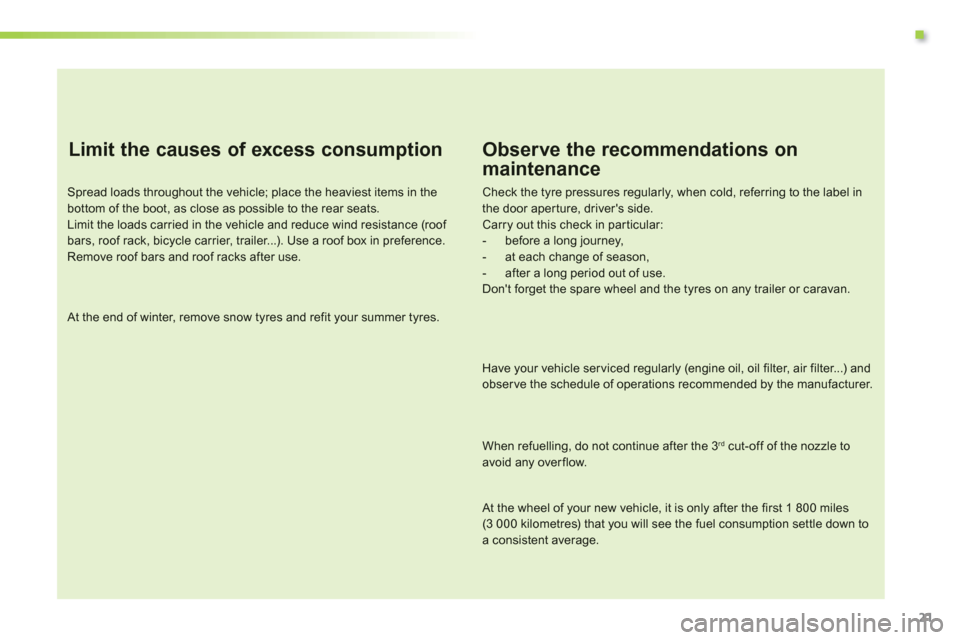
.
21
Limit the causes of excess consumption
Spread loads throughout the vehicle; place the heaviest items in the bottom of the boot, as close as possible to the rear seats.Limit the loads carried in the vehicle and reduce wind resistance (roof bars, roof rack, bicycle carrier, trailer...). Use a roof box in preference.Remove roof bars and roof racks after use.
At the end of winter, remove snow tyres and refit your summer tyres.
Observe the recommendations on
maintenance
Check the tyre pressures regularly, when cold, referring to the label inthe door aperture, driver's side. Carry out this check in par ticular:
- before a long journey,
- at each change of season,
- after a long period out of use.
Don't forget the spare wheel and the tyres on any trailer or caravan.
Have your vehicle ser viced regularly (engine oil, oil filter, air filter...) andobser ve the schedule of operations recommended by the manufacturer.
When refuelling, do not continue after the 3 rd
cut-off of the nozzle toavoid any overflow.
At the wheel of your new vehicle, it is only after the first 1 800 miles (3 000 kilometres) that you will see the fuel consumption settle down toa consistent average.
Page 24 of 284
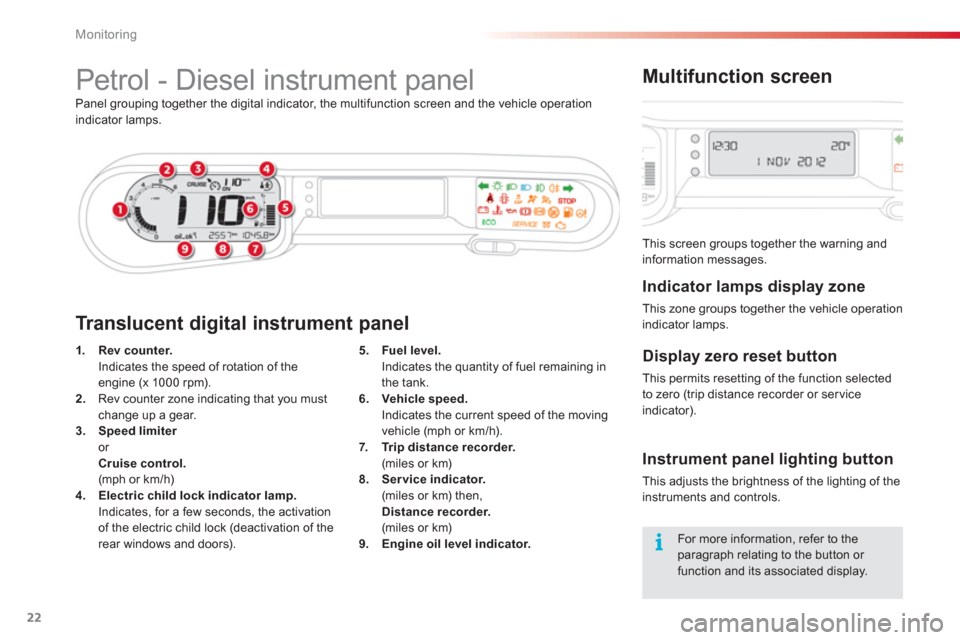
Monitoring
22
Petrol - Diesel instrument panel
Panel grouping together the digital indicator, the multifunction screen and the vehicle operation
indicator lamps.
1.Rev counter.Indicates the speed of rotation of the
engine (x 1000 rpm). 2. Rev counter zone indicating that you must change up a gear.
3.Speed limiterror
Cruise control.(mph or km/h) 4.Electric child lock indicator lamp.Indicates, for a few seconds, the activation
of the electric child lock (deactivation of the rear windows and doors).
Tr a n s l u c e n t d igital instrument panel
This screen groups together the warning and
information messages.
Multifunction screen
Indicator lamps display zone
This zone groups together the vehicle operation indicator lamps.
Display zero reset button
This permits resetting of the function selected
to zero (trip distance recorder or ser vice
indicator).
Instrument panel lighting button
This adjusts the brightness of the lighting of theinstruments and controls. 5
.Fuel level. Indicates the quantity of fuel remaining in
the tank.
6. Vehicle speed. Indicates the current speed of the moving
vehicle (mph or km/h). 7.Trip distance recorder. (miles or km) 8.Service indicator. (miles or km) then,
Distance recorder. (miles or km) 9.Engine oil level indicator.
For more information, refer to the paragraph relating to the button or function and its associated display.
Page 25 of 284
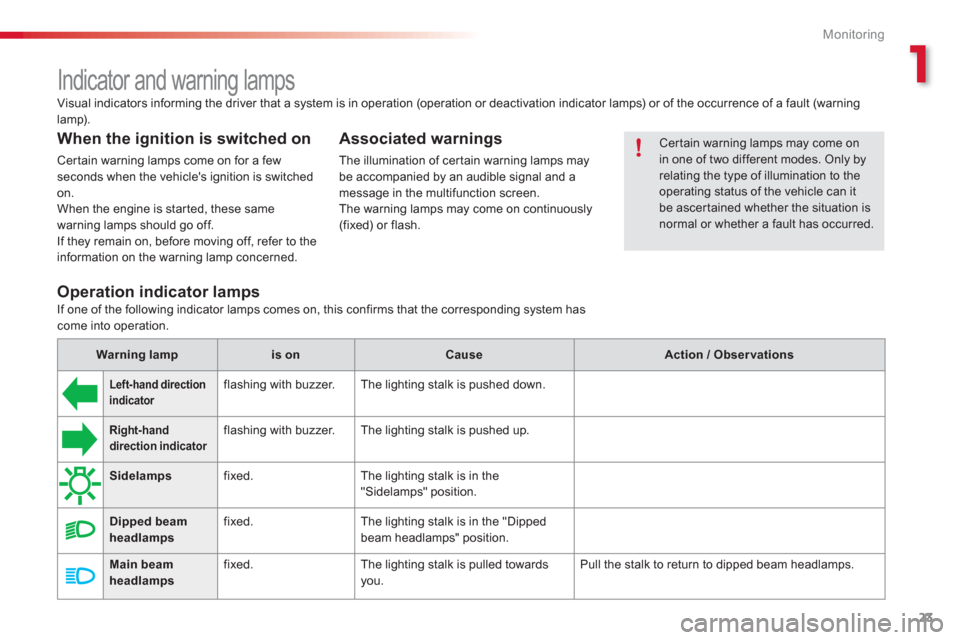
1
Monitoring
23
Indicator and warning lamps
Visual indicators informing the driver that a system is in operation (operation or deactivation indicator lamps) or of the occurrence of a fault (warning
lamp).
Associated warnings
The illumination of certain warning lamps may
be accompanied by an audible signal and amessage in the multifunction screen.
The warning lamps may come on continuously (fixed) or flash.
When the ignition is switched on
Certain warning lamps come on for a few seconds when the vehicle's ignition is switched on.
When the engine is started, these same
warning lamps should go off.
If they remain on, before moving off, refer to the
information on the warning lamp concerned.
Certain warning lamps may come onin one of two different modes. Only by relating the type of illumination to the operating status of the vehicle can itbe ascertained whether the situation isnormal or whether a fault has occurred.
Operation indicator lamps
If one of the following indicator lamps comes on, this confirms that the corresponding system has come into operation.
Warning lampis onCauseAction / Observations
Left-hand directionindicator
flashing with buzzer.The lighting stalk is pushed down.
Right-hand direction indicatorr
flashing with buzzer. The lighting stalk is pushed up.
Sidelamps
fixed. The lighting stalk is in the
"Sidelamps" position.
Dipped beamheadlamps fixed. The lighting stalk is in the "Dipped beam headlamps" position.
Main beam headlamps fixed. The lighting stalk is pulled towardsyou. Pull the stalk to return to dipped beam headlamps.
Page 26 of 284
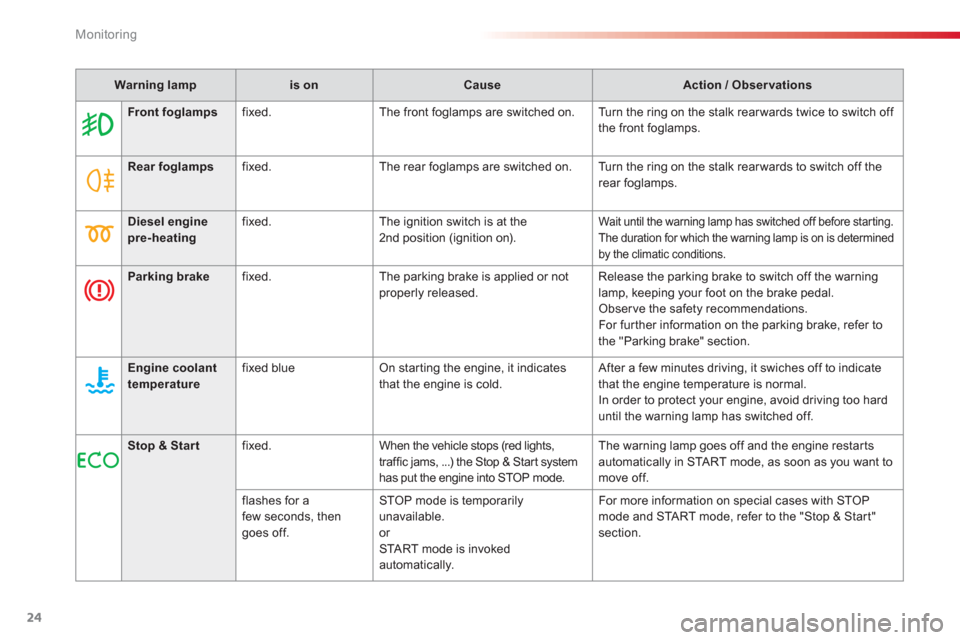
Monitoring
24
Warning lampis onCauseAction / Observations
Front foglampsfixed.The front foglamps are switched on. Turn the ring on the stalk rear wards twice to switch off
the front foglamps.
Rear foglampsfixed.The rear foglamps are switched on. Turn the ring on the stalk rear wards to switch off the
rear foglamps.
Diesel engine pre-heatingfixed.The ignition switch is at the
2nd position (ignition on).Wait until the warning lamp has switched off before starting.
The duration for which the warning lamp is on is determined
by the climatic conditions.
Parking brakefixed.The parking brake is applied or not properly released.Release the parking brake to switch off the warninglamp, keeping your foot on the brake pedal.
Obser ve the safety recommendations.
For further information on the parking brake, refer to
the "Parking brake" section.
Engine coolanttemperaturefixed blueOn starting the engine, it indicates
that the engine is cold. After a few minutes driving, it swiches off to indicate
that the engine temperature is normal. In order to protect your engine, avoid driving too hard
until the warning lamp has switched off.
Stop & Startfixed. When the vehicle stops (red lights,
traffic jams, ...) the Stop & Start system has put the engine into STOP mode.The warnin
g lamp goes off and the engine restarts
automatically in START mode, as soon as you want tomove off.
fl
ashes for afew seconds, then goes off. ST
OP mode is temporarily unavailable. or STA R T m o d e i s i n v o ke dautomatically. For more information on special cases with ST
OP mode and START mode, refer to the "Stop & Start"section.
Page 27 of 284
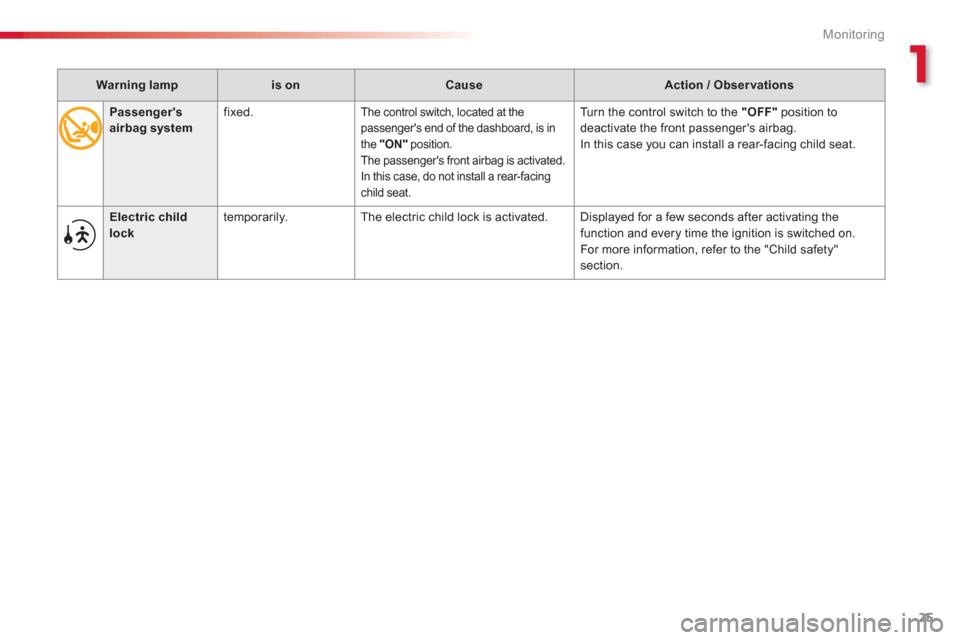
1
Monitoring
25
Passenger's airbag system fixed. The control switch, located at the
passenger's end of the dashboard, is in
the "ON"position.
The passenger's front airbag is activated.
In this case, do not install a rear-facing child seat.
Turn the control switch to the "OFF" position to
deactivate the front passenger's airbag.
In this case you can install a rear-facing child seat.
Warning lampis onCauseAction / Observations
Electric child
lock
temporarily. The electric child lock is activated. Displayed for a few seconds after activating the
function and every time the ignition is switched on.
For more information, refer to the "Child safety"section.
Page 28 of 284
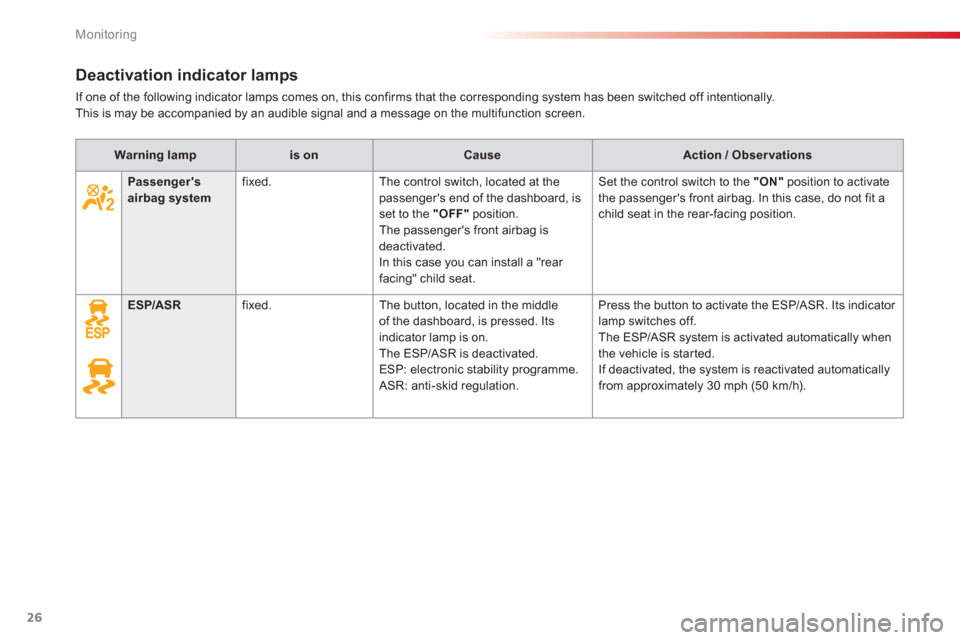
Monitoring
26
Deactivation indicator lamps
If one of the following indicator lamps comes on, this confirms that the corresponding system has been switched off intentionally.
This is may be accompanied by an audible signal and a message on the multifunction screen.
Warning lampis onCauseAction / Observations
Passenger's airbag systemfixed.The control switch, located at thepassenger's end of the dashboard, isset to the "OFF"position.
The passenger's front airbag is deactivated.
In this case you can install a "rear
facing" child seat.
Set the control switch to the "ON"
position to activate
the passenger's front airbag. In this case, do not fit achild seat in the rear-facing position.
ESP/ASRfixed.The button, located in the middle
of the dashboard, is pressed. Its
indicator lamp is on.
The ESP/ASR is deactivated.
ESP: electronic stability programme.
ASR: anti-skid regulation.Pr
ess the button to activate the ESP/ASR. Its indicator
lamp switches off.
The ESP/ASR system is activated automatically when
the vehicle is started.
If deactivated, the system is reactivated automaticallyfrom approximately 30 mph (50 km/h).
Page 29 of 284
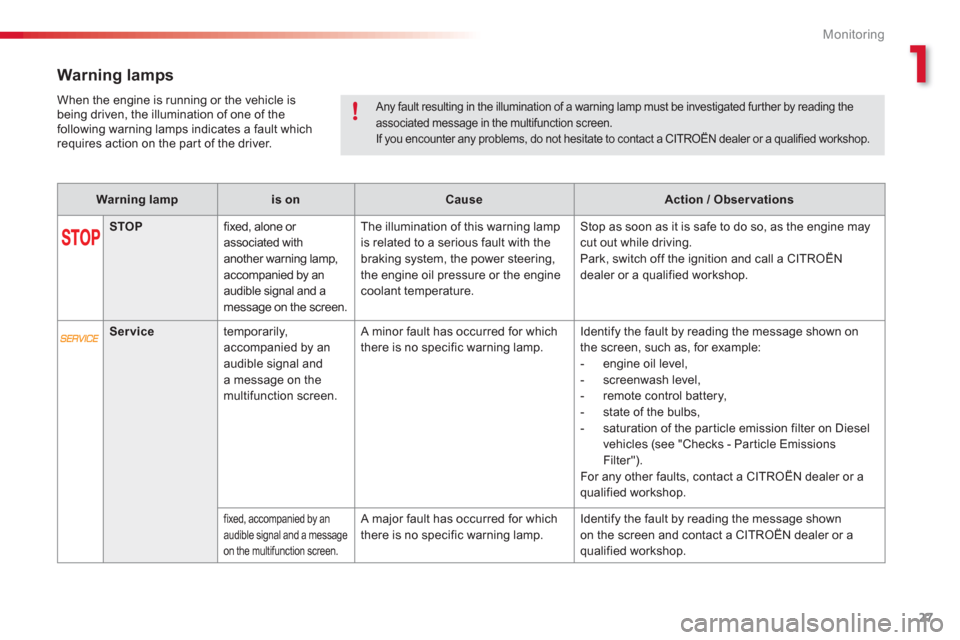
1
Monitoring
27
Warning lamps
Warning lampis onCauseAction / Observations
STOP
fixed, alone or associated with
another warning lamp,
accompanied by an
audible signal and a
message on the screen. The illumination of this warnin
g lamp
is related to a serious fault with thebraking system, the power steering,
the engine oil pressure or the enginecoolant temperature. Stop as soon as it is safe to do so, as the en
gine may cut out while driving.
Park, switch off the ignition and call a CITROËN
dealer or a qualified workshop.
Service
temporarily,
accompanied by an
audible signal and
a messa
ge on the
multifunction screen.
A minor fault has occurred for which
there is no specific warning lamp. Identify the fault by reading the message shown on
the screen, such as, for example:
- engine oil level,
- screenwash level,
- remote control batter
y,
- state of the bulbs,
- saturation of the par ticle emission filter on Diesel
vehicles
(see "Checks - Particle Emissions
Filter").
For any other faults, contact a CITROËN dealer or a qualified workshop.
fixed, accompanied by an
audible signal and a messageon the multifunction screen.
A major fault has occurred for which
there is no specific warning lamp. Identify the fault by reading the message shown
on the screen and contact a CITROËN dealer or a qualified workshop.
Any fault resulting in the illumination of a warning lamp must be investigated further by reading the associated message in the multifunction screen. If you encounter any problems, do not hesitate to contact a CITROËN dealer or a qualified workshop.
When the engine is running or the vehicle is
being driven, the illumination of one of the following warning lamps indicates a fault which
requires action on the par t of the driver.
Page 30 of 284
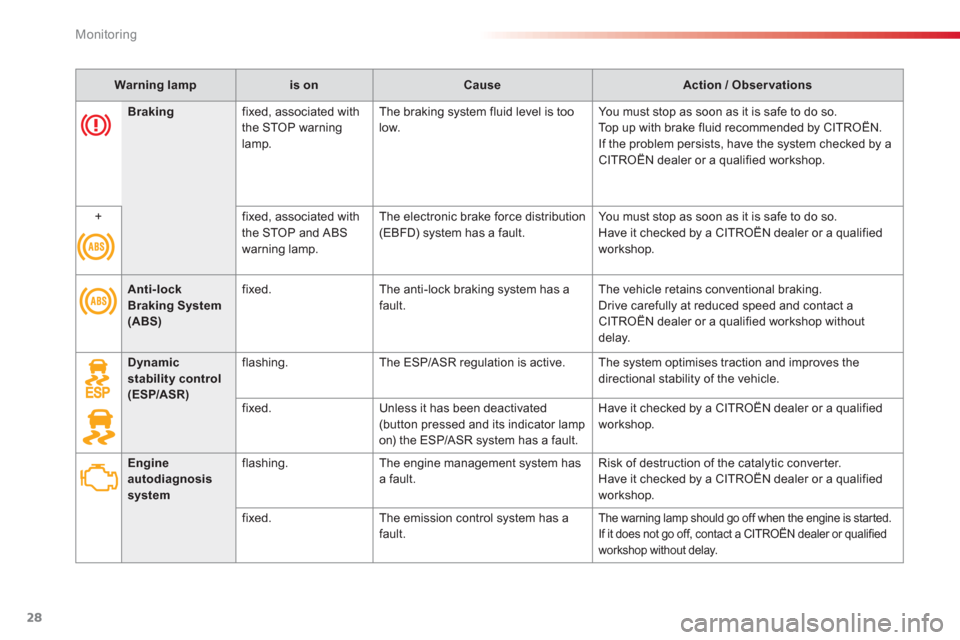
Monitoring
28
Warning lampis onCauseAction / Observations
Anti-lockBraking System(ABS)
fixed. The anti-lock braking system has a
fault. The vehicle retains conventional braking.
Drive carefully at reduced speed and contact a CITROËN dealer or a qualified workshop without
delay.
Dynamic stability control(ESP/ASR)
flashing. The ESP/ASR regulation is active. The system optimises traction and improves the
directional stability of the vehicle.
fixed. Unless it has been deactivated(button pressed and its indicator lamp
on) the ESP/ASR system has a fault. Have it checked b
y a CITROËN dealer or a qualified
workshop.
Engine autodiagnosis system
flashing.The engine management system hasa fault. Risk of destruction of the catalytic conver ter.
Have it checked by a CITROËN dealer or a qualified
workshop.
fix
ed. The emission control system has a
f
ault.
The warning lamp should go off when the engine is started.
If it does not
go off, contact a CITROËN dealer or qualified
workshop without delay.
Brakingfixed, associated with
the STOP warning
lamp. The braking system fluid level is too
low.You must stop as soon as it is safe to do so.
Top up with brake fluid recommended by CITROËN.
If the problem persists, have the system checked by a
CITROËN dealer or a qualified workshop.
+ fixed, associated with
the
STOP and ABS
warning lamp.Th
e electronic brake force distribution(EBFD) system has a fault.You must stop as soon as it is safe to do so.
Have it checked by a CITROËN dealer or a qualified
workshop.